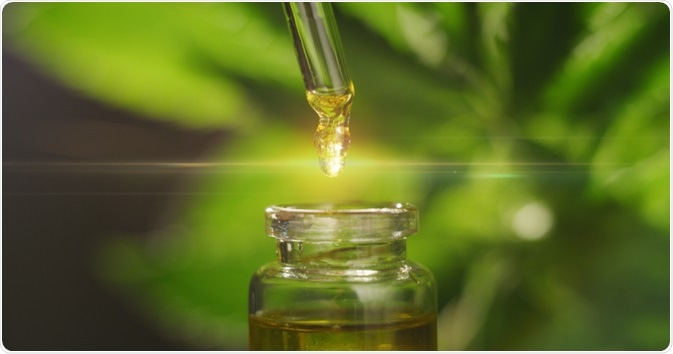Hemp seeds come from a non-psychoactive form of the plant Cannabis sativa L. Due to their rich nutritional profile, they are used as a food source, as well as for their pharmaceutical properties and in animal feed. Therefore, there is a need for reliable, innovative methods to characterize the compounds found in hemp seed products.

Image Credit:Shutterstock/HQualilty
A number of approaches have already been applied to hemp analysis. Cannabidiol (CBD), the primary cannabinoid in C.sativa, has typically been analyzed with conventional approaches such as HPLC or GC coupled to an array or mass spectrometer. Experimental methods have been used for analyte quantitation, like ERETIC and QUANTAS. Increasingly, NMR is applied to hemp and cannabis analysis, because it allows direct molecular profiling. As well as being quick and providing detailed information, samples can be directly analyzed without the need for chemical or physical pretreatment. However, the use of quantitative NMR for analyzing hemp seed products has been limited.
This method requires the use of internal or external standards in order to calibrate the experiment. This can have some drawbacks, including being time-consuming to prepare and organic compounds have the potential to introduce sample contamination.
Researchers from the University of Calabria in Italy explored whether using an “intrinsic” internal standard could offer a quick and convenient approach to quantifying CBD content in hemp seed samples.
The team used isotopically impure chloroform, with a purity of 99.5% and therefore containing 0.5% unlabeled chloroform. By dissolving the sample in this solution, this unlabeled chloroform can act as an intrinsic internal standard and be used both to calibrate the spectra and, because each sample contains a known weight, to measure the amount of CBD.
For calibration, the team dissolved a sample of pure CBD in the deuterated chloroform. Recording spectra with a Bruker Avance 300 NMR spectrometer, they were able to show that the method performed well by a number of parameters including linearity range, accuracy, limit of detection and limit of quantification. They then analyzed samples of hemp seed flour extract, hemp seed oil, and hemp seed cake, a by-product from hemp seed oil extraction that is sometimes used as animal feed. They determined that the CBD concentration of these samples was 1.28 mg/mL, 2.16 mg/mL, and 1.65 mg/mL, respectively.
The researchers highlight that the approach allowed for the direct solvent extraction of the matrices without the need for chemical or physical manipulation, nor chromatography. By using an intrinsic internal standard, it avoided the use of additional organic compounds. They say it therefore represents a new, fast, and reliable approach to extracting and quantifying the CBD content in hemp seed products, which could also be applied to other cannabinoids in future.
The global Cannabis Industry shows huge growth rates by opening new fields of applications, like pharmaceutical patient treatment. CBD is one of the most promising components in that area. By providing the most innovative technology Bruker enables the Cannabis Industry to ensure a safe and sound supply chain with authentic and consistent raw materials and processed goods including proven efficacy in medical applications.
Bruker does not support, encourage, or intend that its products or services be used in connection with any illegal use, cultivation or trade of cannabis or cannabis products. Bruker products are intended to be used only in compliance with all applicable laws in a manner that promotes public safety and in connection with any lawful and approved scientific or medical research activities.
Reference
Siciliano C, Bartella L, Mazzotti F et al. 1H NMR quantification of cannabidiol (CBD) in industrial products derived from Cannabis sativa L. (hemp) seeds. IOP Conf. Series: Materials Science and Engineering 2019; 572:012010. doi: 10.1088/1757-899X/572/1/012010.
About Bruker BioSpin Group
The Bruker BioSpin Group designs, manufactures, and distributes advanced scientific instruments based on magnetic resonance and preclinical imaging technologies. These include our industry-leading NMR and EPR spectrometers, as well as imaging systems utilizing MRI, PET, SPECT, CT, Optical and MPI modalities. The Group also offers integrated software solutions and automation tools to support digital transformation across research and quality control environments.
Bruker BioSpin’s customers in academic, government, industrial, and pharmaceutical sectors rely on these technologies to gain detailed insights into molecular structure, dynamics, and interactions. Our solutions play a key role in structural biology, drug discovery, disease research, metabolomics, and advanced materials analysis. Recent investments in lab automation, optical imaging, and contract research services further strengthen our ability to support evolving customer needs and enable scientific innovation.
Sponsored Content Policy: News-Medical.net publishes articles and related content that may be derived from sources where we have existing commercial relationships, provided such content adds value to the core editorial ethos of News-Medical.Net which is to educate and inform site visitors interested in medical research, science, medical devices and treatments.